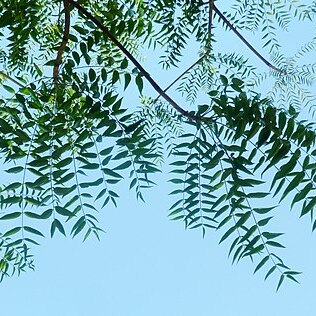It is a deciduous tree. It grows 6-16 m tall. It has a clean trunk. The branches are straight. The bark is grey and smooth when young but becomes corrugated in old age. The leaves are 10-45 cm long. The leaves have 6-10 pairs of leaflets. They are larger towards the tip. The leaflets are 2-8 cm long by 1-3 cm wide. The flowering stalks are branched and hairy with several flowers. The flowers are pale green to cream and of 2 forms some being male and others female. The fruit are 1-2 cm long and about 1 cm wide. They are woody.
Leaves 10–45 cm. long, viscid when young, densely pubescent (then ± glabrescent) to glabrous, hairs proportionately more numerous on the rhachis and on the midrib of the leaflet above and below than on the lamina; petiole 3–10 cm. long; leaflets sessile or subsessile, 6–10-jugate, somewhat larger towards the distal end; lamina 2–8 × 1–2·5 cm., narrowly ovate to lanceolate, apex acuminate to long-acuminate, margin crenulate, base ± asymmetric.
Gynoecium in male flowers a minute vestige lying centrally on the disk; in female flowers glabrous to pubescent consisting of (before anthesis) four erect narrowly flask-shaped carpels fused at the base but diverging above into the styles which are free at the base but united above, stigmas united, capitate; after anthesis styles deciduous above the base.
Medium-sized deciduous tree 6–16 m. tall with clean bole, well branched above with straightish branches; bark grey, smooth when young, flaking later, corrugated in old age; young twigs with prominent ± rhombic leaf scars 2–5 × 3–7 mm.
Stamens in male flowers with filaments 3–4 mm. long, tapering towards the apex, glabrous; anthers 0·7 mm. long; in female flowers stamens about half the size of those in the male flowers and apparently non-functional.
Petals spreading, c. 4 mm. long, narrowly triangular with subacute apex and minute globose loosely attached glands at the base within, glabrous within, sometimes pubescent along the middle outside.
Tree, up to 17 m high. Leaves usually fewer than 10 pairs of leaflets, leaflets elliptic, 29-88 x 10-24 mm, base slightly oblique, margin crenate, bright scarlet in autumn. Flowers white to cream.
Fruit 0·8–2 × 0·5–1 cm., woody, oblong-ellipsoid, tetragonal with very acute angles, glabrous, with what are apparently recurved style-bases at the top.
Inflorescences much branched, with minute bracts, pubescent (then ± glabrescent) to glabrous, viscid, with numerous flowers.
Flowers pale green to cream, pubescent to glabrous, dimorphic (some functionallyfemale, some functionally male).
Sepals 1·5–2 × 1·5–2 mm., triangular to circular, densely pubescent to glabrous outside, glabrous within.
Seed almost as large as, and apparently fused with the mericarp.


